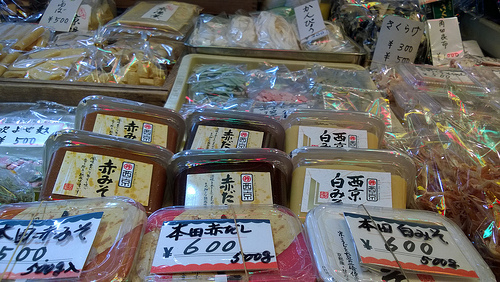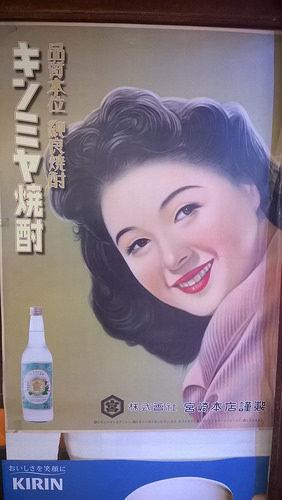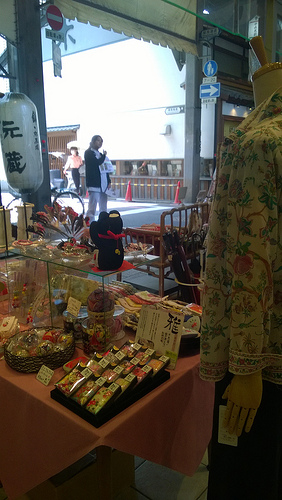Verify out these locate chinese suppliers pictures:
河原町周辺-錦市場

Image by Japanologia
I cannot describe all sensations I felt when I visited Kyoto for the very first time in my life. That I have a particular relationship with Japan, properly, that’s no news. But Kyoto has this special power, unbelievable and indescribable, that requires each and every visitor back in time to a distant previous, and for a lot of, a surreal past, as if we have been displaced from the space-time continuum.
Kyoto was established in the 7th century in a land named Yamashiro-no-kuni by the Emperor Kammu. Strictly following the Chinese geomancy from the Tang Dinasty (you can see it in the city layout, the grid pattern and the disposition of squares and blocks), the feng shui guidelines and the organic protection supplied by its surrounding mountains, Kyoto, formerly known as Heiankyō, was the second capital of Japan, preceded by Heijōkyō, Nara.
Strongly influenced by the Chinese culture, Buddhism, literature, music, dance, arts and laws, Kyoto skilled the Heian Period, deemed by some as the apogee or epitome of nobility and court life. Known to this day as one particular of the biggest centers of the higher Japanese art, Kyoto is a city that still exudes grace, regardless of the district in which you are situated.
If you want to get the very best high quality craft products or even meet other facets of Japanese cuisine, you definitely need to go to Kyoto, a mandatory place to every single visitor who lands on Japanese territory. About Japanese cuisine, effectively, I came to speak about a unique location whose classic shops are practically endless sources of ingredients not only for everyday life, but also for the best restaurants in town. These days I’ll speak about Kyoto’s Kitchen.
A few months ago I wrote an post about the gastronomic adventures of Jiro Taniguchi and Masayuki Kusumi in the remarkable manga "Gourmet" (孤独のグルメ). As I wrote in that text, a single of the ideal experiences you can have in Japan is to meet such a diverse and fantastically tasty cuisine, sometimes locating surprises in unexpected areas that transcends that logic that “in Japan they only consume sushi, sashimi and Temaki”.
Once more, for typical Japanese dishes, I’m talking about what you consume in the everyday life in the Land of the Increasing Sun. No, not that stupidity to feel that Japan was taken by temakis. Numerous of my friends are nevertheless shocked to find out that there are many much more items than sushi and sashimi. One particular of the best areas to comprehend, to feel, to smell and to taste this dimension of the Japanese every day life is going to the Nishiki Market or Nishiki Ichiba (錦市場), a magic location consisted by lengthy and arrow blocks close to the Teramachi Arcade (寺町通) and quite close to Pontochō (先斗町).
Its initial classic shops dates from the 14th century, becoming a single of the most critical fish suppliers of town. Nishiki Ichiba gradually turned into a huge marketplace, whose variety of goods involves not only food and ingredients for cooking, but also crafts, porcelain and other products for each day life. Alongside the bric-a-brac shops, greengrocers, rice shops, fishmongers, pastry shops and ice cream parlors there are a number of restaurants serving typical food. At the finish, the tour in Nishiki Ichiba can final for hours, filled with great meals that is completely unknown to foreigners.
With its higher ceilings and green, red and yellow glass tiles, Nishiki Ichiba is crowded with all kinds of people, all of them immersed in a globe of infinite smells and tastes.
The 1st time I was in Nishiki Ichiba I was accompanied by the presence of great close friends, 1 of them a resident of Kyoto in those instances. Understanding every alley and city streets, she took us to 1 of the most impressive areas of Kyoto, a market place that fascinated me quickly. Come on, Japan is certainly not a spot invaded by sushi-monsters, sashimi-zillas or temaki-robots.
It took years for me to return, this time paying attention to other particulars that go unnoticed that time. Initially becoming a profusion of signs for all the senses, now the Nishiki Ichiba was a very familiar location, whose tenants and Japanese purchasers had been all extremely kind, who did not hesitate to strike up a conversation with a stranger fascinated by Japanese culture. In spite of getting a tourist town, they showed enthusiasm in speaking, in Japanese, to a japanologist researcher who felt back at house. For a brief moment, every thing seemed frozen in time. Or at least it seemed that time passed more gradually inside that market place. Worry less about sushi, temples, shrines and all that hightech mumbo jumbo and let be hooked by the stomach. Give it a attempt. I guarantee you it will be delicious.
by Victor Hugo Kebbe
河原町周辺-錦市場

Image by Japanologia
I can’t describe all sensations I felt when I visited Kyoto for the 1st time in my life. That I have a unique partnership with Japan, properly, that is no news. But Kyoto has this unique energy, unbelievable and indescribable, that takes every visitor back in time to a distant previous, and for numerous, a surreal past, as if we have been displaced from the space-time continuum.
Kyoto was established in the 7th century in a land referred to as Yamashiro-no-kuni by the Emperor Kammu. Strictly following the Chinese geomancy from the Tang Dinasty (you can see it in the city layout, the grid pattern and the disposition of squares and blocks), the feng shui suggestions and the organic protection presented by its surrounding mountains, Kyoto, formerly recognized as Heiankyō, was the second capital of Japan, preceded by Heijōkyō, Nara.
Strongly influenced by the Chinese culture, Buddhism, literature, music, dance, arts and laws, Kyoto knowledgeable the Heian Period, considered by some as the apogee or epitome of nobility and court life. Identified to this day as one particular of the biggest centers of the high Japanese art, Kyoto is a city that still exudes grace, regardless of the district in which you are positioned.
If you want to get the greatest good quality craft things or even meet other facets of Japanese cuisine, you absolutely must go to Kyoto, a mandatory location to each and every visitor who lands on Japanese territory. About Japanese cuisine, nicely, I came to speak about a special location whose traditional shops are almost endless sources of ingredients not only for daily life, but also for the ideal restaurants in town. Right now I’ll talk about Kyoto’s Kitchen.
A few months ago I wrote an post about the gastronomic adventures of Jiro Taniguchi and Masayuki Kusumi in the incredible manga "Gourmet" (孤独のグルメ). As I wrote in that text, one of the ideal experiences you can have in Japan is to meet such a diverse and fantastically tasty cuisine, occasionally finding surprises in unexpected places that transcends that logic that “in Japan they only consume sushi, sashimi and Temaki”.
Once more, for typical Japanese dishes, I’m talking about what you eat in the everyday life in the Land of the Rising Sun. No, not that stupidity to believe that Japan was taken by temakis. Numerous of my close friends are nonetheless surprised to discover that there are numerous far more issues than sushi and sashimi. 1 of the greatest places to recognize, to feel, to smell and to taste this dimension of the Japanese every day life is going to the Nishiki Marketplace or Nishiki Ichiba (錦市場), a magic place consisted by lengthy and arrow blocks near the Teramachi Arcade (寺町通) and really close to Pontochō (先斗町).
Its initial classic shops dates from the 14th century, becoming one of the most important fish suppliers of town. Nishiki Ichiba steadily turned into a massive market place, whose range of merchandise consists of not only food and components for cooking, but also crafts, porcelain and other merchandise for daily life. Alongside the bric-a-brac shops, greengrocers, rice shops, fishmongers, pastry shops and ice cream parlors there are a number of restaurants serving standard meals. At the finish, the tour in Nishiki Ichiba can last for hours, filled with good food that is completely unknown to foreigners.
With its higher ceilings and green, red and yellow glass tiles, Nishiki Ichiba is crowded with all sorts of folks, all of them immersed in a globe of infinite smells and tastes.
The very first time I was in Nishiki Ichiba I was accompanied by the presence of excellent pals, one particular of them a resident of Kyoto in these instances. Being aware of each and every alley and city streets, she took us to one of the most impressive locations of Kyoto, a industry that fascinated me immediately. Come on, Japan is undoubtedly not a location invaded by sushi-monsters, sashimi-zillas or temaki-robots.
It took years for me to return, this time paying consideration to other specifics that go unnoticed that time. Initially getting a profusion of indicators for all the senses, now the Nishiki Ichiba was a extremely familiar place, whose tenants and Japanese buyers have been all quite type, who did not hesitate to strike up a conversation with a stranger fascinated by Japanese culture. In spite of becoming a tourist town, they showed enthusiasm in speaking, in Japanese, to a japanologist researcher who felt back at house. For a quick moment, every thing seemed frozen in time. Or at least it seemed that time passed more slowly inside that market. Be concerned less about sushi, temples, shrines and all that hightech mumbo jumbo and let be hooked by the stomach. Give it a try. I assure you it will be delicious.
by Victor Hugo Kebbe
河原町周辺-錦市場

Image by Japanologia
I can not describe all sensations I felt when I visited Kyoto for the first time in my life. That I have a specific relationship with Japan, effectively, that’s no news. But Kyoto has this particular power, unbelievable and indescribable, that requires each visitor back in time to a distant past, and for many, a surreal past, as if we were displaced from the space-time continuum.
Kyoto was established in the 7th century in a land named Yamashiro-no-kuni by the Emperor Kammu. Strictly following the Chinese geomancy from the Tang Dinasty (you can see it in the city layout, the grid pattern and the disposition of squares and blocks), the feng shui guidelines and the all-natural protection presented by its surrounding mountains, Kyoto, formerly recognized as Heiankyō, was the second capital of Japan, preceded by Heijōkyō, Nara.
Strongly influenced by the Chinese culture, Buddhism, literature, music, dance, arts and laws, Kyoto seasoned the Heian Period, regarded by some as the apogee or epitome of nobility and court life. Identified to this day as one of the largest centers of the high Japanese art, Kyoto is a city that still exudes grace, regardless of the district in which you are situated.
If you want to get the very best high quality craft items or even meet other facets of Japanese cuisine, you definitely need to go to Kyoto, a mandatory spot to every visitor who lands on Japanese territory. About Japanese cuisine, well, I came to talk about a particular location whose classic shops are virtually endless sources of ingredients not only for daily life, but also for the ideal restaurants in town. These days I’ll speak about Kyoto’s Kitchen.
A handful of months ago I wrote an post about the gastronomic adventures of Jiro Taniguchi and Masayuki Kusumi in the wonderful manga "Gourmet" (孤独のグルメ). As I wrote in that text, one particular of the ideal experiences you can have in Japan is to meet such a diverse and fantastically tasty cuisine, often finding surprises in unexpected areas that transcends that logic that “in Japan they only consume sushi, sashimi and Temaki”.
Once more, for common Japanese dishes, I’m speaking about what you eat in the daily life in the Land of the Rising Sun. No, not that stupidity to consider that Japan was taken by temakis. Many of my friends are nevertheless surprised to learn that there are numerous far more factors than sushi and sashimi. One of the best locations to comprehend, to feel, to smell and to taste this dimension of the Japanese every day life is going to the Nishiki Marketplace or Nishiki Ichiba (錦市場), a magic spot consisted by extended and arrow blocks close to the Teramachi Arcade (寺町通) and very close to Pontochō (先斗町).
Its first traditional shops dates from the 14th century, becoming one of the most important fish suppliers of town. Nishiki Ichiba progressively turned into a big industry, whose range of products involves not only meals and ingredients for cooking, but also crafts, porcelain and other merchandise for each day life. Alongside the bric-a-brac shops, greengrocers, rice shops, fishmongers, pastry shops and ice cream parlors there are a number of restaurants serving typical food. At the finish, the tour in Nishiki Ichiba can final for hours, filled with excellent food that is completely unknown to foreigners.
With its higher ceilings and green, red and yellow glass tiles, Nishiki Ichiba is crowded with all kinds of folks, all of them immersed in a world of infinite smells and tastes.
The very first time I was in Nishiki Ichiba I was accompanied by the presence of fantastic close friends, a single of them a resident of Kyoto in those occasions. Being aware of every single alley and city streets, she took us to a single of the most impressive places of Kyoto, a market place that fascinated me instantly. Come on, Japan is definitely not a location invaded by sushi-monsters, sashimi-zillas or temaki-robots.
It took years for me to return, this time paying focus to other information that go unnoticed that time. Initially being a profusion of indicators for all the senses, now the Nishiki Ichiba was a very familiar location, whose tenants and Japanese purchasers were all extremely sort, who did not hesitate to strike up a conversation with a stranger fascinated by Japanese culture. Regardless of becoming a tourist town, they showed enthusiasm in speaking, in Japanese, to a japanologist researcher who felt back at residence. For a short moment, every little thing seemed frozen in time. Or at least it seemed that time passed a lot more gradually inside that marketplace. Worry significantly less about sushi, temples, shrines and all that hightech mumbo jumbo and let be hooked by the stomach. Give it a attempt. I assure you it will be delicious.
by Victor Hugo Kebbe